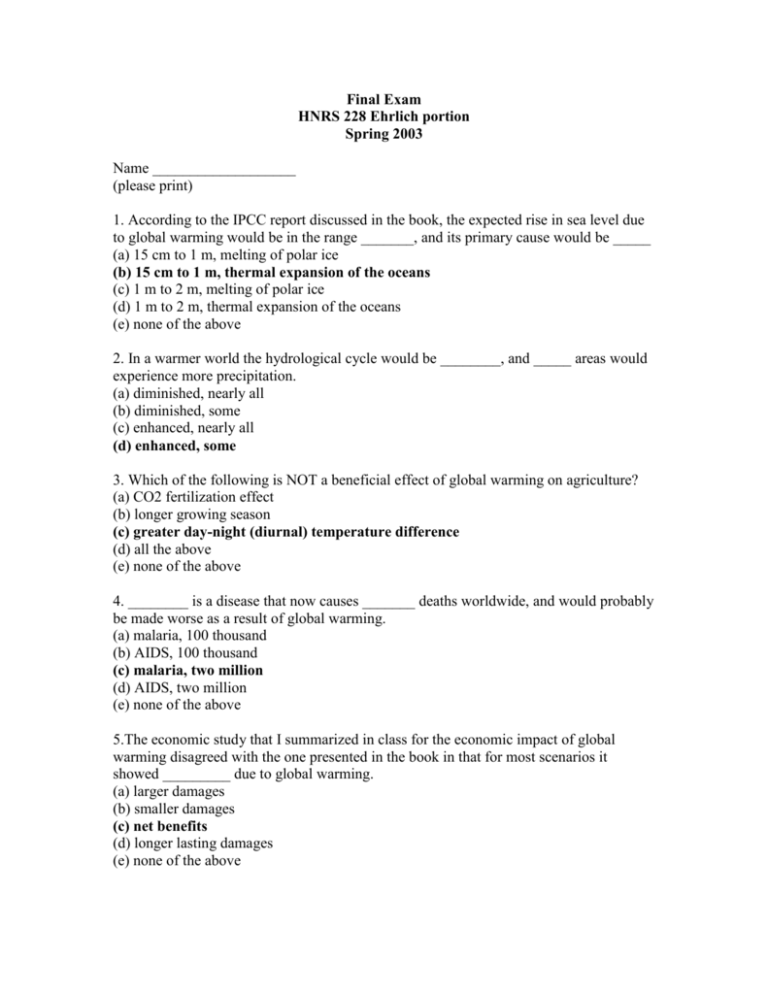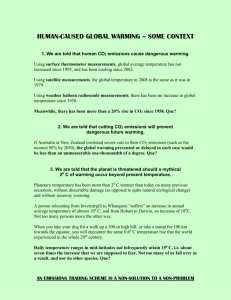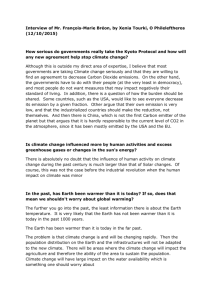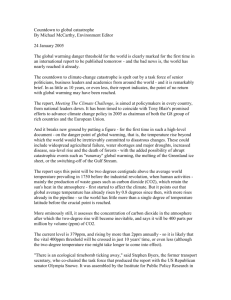Final Exam
advertisement

Final Exam HNRS 228 Ehrlich portion Spring 2003 Name ___________________ (please print) 1. According to the IPCC report discussed in the book, the expected rise in sea level due to global warming would be in the range _______, and its primary cause would be _____ (a) 15 cm to 1 m, melting of polar ice (b) 15 cm to 1 m, thermal expansion of the oceans (c) 1 m to 2 m, melting of polar ice (d) 1 m to 2 m, thermal expansion of the oceans (e) none of the above 2. In a warmer world the hydrological cycle would be ________, and _____ areas would experience more precipitation. (a) diminished, nearly all (b) diminished, some (c) enhanced, nearly all (d) enhanced, some 3. Which of the following is NOT a beneficial effect of global warming on agriculture? (a) CO2 fertilization effect (b) longer growing season (c) greater day-night (diurnal) temperature difference (d) all the above (e) none of the above 4. ________ is a disease that now causes _______ deaths worldwide, and would probably be made worse as a result of global warming. (a) malaria, 100 thousand (b) AIDS, 100 thousand (c) malaria, two million (d) AIDS, two million (e) none of the above 5.The economic study that I summarized in class for the economic impact of global warming disagreed with the one presented in the book in that for most scenarios it showed _________ due to global warming. (a) larger damages (b) smaller damages (c) net benefits (d) longer lasting damages (e) none of the above 6. Which of the following can we probably have the LEAST confidence in? (a) global warming now has a significant anthropogenic component (b) U.S. farmers would probably be able to adapt to warmer temperatures (c) the most damaging effects of global warming would be more extreme events (droughts, floods and severe storms) – assuming they occur (d) the likely monetary costs of global warming by 2100 are well understood (e) none of the above 7. Which of the following GW technical fixes probably holds the most promise? (a) removing CO2 during combustion of fossil fuels (b) removing CO2 from the atmosphere after it has been added (c) spreading iron oxide over the oceans to stimulate the biological pump (d) putting many mirrors in space (e) none of the above 8. Suppose an economic study calculated a cost C to reduce CO2 emissions by a certain percentage P. Most likely the cost to reduce emissions by an amount 2P would be ____ (a) 2C (b) between C and 2C (c) more than 2C (d) 4C 9. The Kyoto Climate Treaty currently stipulates that _____ nations should reduce their greenhouse gas emissions by an average of _____ below 1990 levels. (a) all, 5% (b) developed, 5%, (c) all, 50% (d) developed, 50% 10. Which fossil fuel energy source does the world posses in greatest abundance? (a) gas (b) oil (c) coal (d) uranium 11. Which of these energy sources is not ultimately due to the sun? (More than one may be right.) (a) fossil fuels (b) wind (c) nuclear (d) geothermal 12. Consider three countries A.B and C. A uses twice as much energy as either B or C, while B has twice the GNP of A or C. Which nation has the lowest energy intensity? (a) A (b) B (c) C (d) all are equal 13. What is the typical efficiency for generating electricity? (a) 10% (b) 25% (c) 50% (d) 75% (e) none of them 14. If your home appliances have an average efficiency for their type, in which case would replacing the appliance with the most efficient version available probably result in the SMALLEST energy savings? (a) furnace (b) stove (c) refrigerator (d) television 15. Which form of renewable energy is now in greatest use on a worldwide basis? (a) solar cells (b) wind (c) geothermal (d) traditional biomass 16. A typical modern wind generator might be expected to generate on average _______, which is enough to supply _______ homes with electricity. (a) a few megawatts, 1000 (b) a few kilowatts, 1000 (c) a few megawatts, 100 (d) a few kilowatts, 100 (e) none of the above 17. A certain wind generator produces an amount of power P when the wind blows at 5 mph. How much power would it produce when the wind speed is 15 mph? (a) 2P (b) 3P (c) 8P (d) 27P (e) none of them 18. Two renewable energy options that are probably the MOST restricted in their geographical applicability are: (a) hydropower and solar (b) solar and geothermal (c) geothermal and tidal (d) hydropower and tidal 19. Which of the following is NOT a major factor in limiting the widespread use of solar energy? (a) cost (b) unfamiliarity (c) maintenance (d) inadequate technology 20. Current nuclear reactors are based on ______ reactions, and they _____ contribute significantly to the problem of global warming (a) fusion, do (b) fusion, do not (c) fission, do (d) fission, do not 21. Which of these nations would probably be least affected by rising sea levels? (a) Bangladesh (b) China (c) the Netherlands (d) U.S. 22. In a warmer world, natural ecosystems would probably be harmed _____ than agriculture, especially various species of _____. (a) less, trees (b) more, trees (c) less, birds (d) more, birds 23. Of the three positions on global warming: (1) wait and see, (2) precautionary principle, or (3) technical fixes, the book’s author decidedly comes down in favor of ___, while your instructor leans towards ____. (a) 1,2 (b) 1,3 (c) 2,1 (d) 2,3 (e) 3,2 24. Let D = the cost of damages inflicted by a given level of CO2 emissions, and C = the costs of preventing it. The optimum emissions reduction to strive for is that which (a) maximizes C-D (b) minimizes C-D (c) maximizes C+D (d) minimizes C+D 25. The biggest change in U.S. energy usage since World War II has been the ____ in the use of _____ (a) reduction, coal (b) increase, coal (c) reduction, oil (d) increase, oil Essay question 1 Describe all the pros and cons of solar energy (using solar cells), and also describe the kinds of situations and settings in which it would be a viable option at present. Essay question 2 Describe all the impacts of global warming on humans and ecosysytems, and assess the severity of each, and our degree of certainty in each case. Essay question 3 Describe in detail the pros and cons for the “wait and see” position towards global warming. Essay question 4 Describe all the various renewable energy options other than solar cells, and discuss the pros and cons of each.







